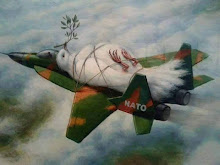Record suicides prove our right to refuse to fight
August 23, 2012
By Michael Prysner
|
The author is a former corporal in the U.S. Army and a veteran of the Iraq war.
The U.S. Army revealed that July yielded the highest number of
active-duty soldier suicides on record, with 38 in just a single month
(this number does not include other branches of service, or Iraq and
Afghanistan veterans who commit suicide once they get out of the
military).
In the same month, 30 U.S. soldiers were killed in
Afghanistan, the highest number in a single month so far this year, who
should have never been sent to their deaths in the first place.
Suicides outpacing combat deaths has been a reality for years. In
2008, 2009 and 2010 there were more suicides in the active-duty Army
than there were killed in Afghanistan.
Those who took their own
lives, in reality, did not kill themselves. Our psychological bleeding
started when we were sent by lying, crooked politicians to occupy a
civilian population against their will. Once the bleeding started, they
were killed by the long-exposed willful negligence by the military
chain-of-command and millionaire politicians who refuse to address the
suicide crisis and say there’s “not enough money” for adequate mental
health services (all while they write blank checks to
multi-billion-dollar defense contractors.)
The suicide epidemic
and failure crisis in Army mental health is not a new story. The
military brass and politicians in Washington have been well-aware, with
intense public pressure, that urgent, emergency action is needed to stop
the daily (yes, daily) suicide of active-duty troops.
But, their response to the epidemic
—being experienced by those they pat on the back and say “we support the troops” when they send us to war
—has
not only been complete inaction in making necessary changes to address
the crisis, but in fact trying harder to deny treatment for PTSD and
sweep the problem under the rug.
Our officers are the real enemy and danger to our lives
The
worst offenders have been our own commanding officers. It is a known
fact that general officers have ordered their subordinate Army
psychologists to
not diagnose soldiers with PTSD in order to
keep those soldiers eligible to deploy to combat again, and to deny them
compensation and treatment that “wastes taxpayer money.” Soldiers can
literally walk into a mental health clinic on base with documented
combat experience and trauma, tell the doctor they want to commit
suicide, beg for help, and be told they are fine and sent back to their
unit.
In addition to scandals over denying a legitimate
diagnosis and treatment, the officer corps is responsible for creating a
culture of harassment, intimidation and shame for those seeking help
for PTSD. Anyone serving in today’s military knows the reality for
traumatized troops; they are called a “malingerers,” told they are
lying, are publicly berated and shamed in their units for seeking help,
forced to deploy again and even formally punished for their symptoms.
Even
if a soldier is lucky enough to get diagnosed and medically discharged
with PTSD, the officer-run discharge process can take years and is so
notoriously grueling, unfair, uncaring and stressful, that it is more
likely to drive soldiers closer to suicide.
The officers’
facilitation of criminally negligent and inadequate treatment, coupled
with the encouraged, open culture of shame and intimidation for those
seeking help, it is no surprise that so many resort to suicide. Yet,
every time these shocking statistics come out, the officers scratch
their heads and say “we have no idea why this is happening!”
Sometimes they reveal their true feelings, like top commander at Fort Bliss, Major General Dana Pittard, who said
in an official blog post
“I’m personally fed up with soldiers who are choosing to take their own
lives so that others can clean up their mess... suicide is an
absolutely selfish act... be an adult and deal with your problems like
the rest of us.”
Just like when a police department investigates
itself for its own acts of misconduct, it’s no surprise the officer
corps absolves themselves of all responsibility when their blatant
misconduct is in the spotlight.
If a soldier was lying on the
battlefield with a bullet wound and their commanding officer accused
that soldier of lying, made fun of them, and did not allow the medic to
treat the wound, that officer would (maybe) be disciplined when that
soldier died. But when they do the same exact thing to wounded troops
with PTSD, on a massive scale with hundreds now needlessly lost to
suicide, they don’t even get a slap on the wrist.
And if a
commanding officer was known to deny wounded soldiers on the battlefield
a tourniquet or field dressing to make them needlessly bleed to death,
it would be perfectly reasonable and accepted for the soldiers under him
to refuse their orders into combat. The situation with suicide and PTSD
is no different.
The 38 Army suicides in July are the direct
result of the actions of the officers who are in control of our lives.
And with 30 soldiers killed in action in July, it reveals that in
reality our own officers are more a danger to our lives than the
so-called “enemy.”
There is a way out
Also
in July, along with the highest suicides on record, the most revealing
Pentagon-funded study on military suicides was released. Dozens of
soldiers who had attempted suicide and failed were polled about why they
did so. The conclusion was this: “It’s not that people who attempt
suicide want to harm themselves... but they want the pain they’re in to
stop and
they don’t see any other way out.”
This
reveals plainly and conclusively that the unwillingness and inability
of the officer corps to treat psychologically traumatized soldiers with
any dignity or fairness, locking them in a maze of a broken health care
system with cruel harassment to top it off, feeling that there is no
escape from that nightmare but death, is the reason we’re killing
ourselves at the rate of one per day.
But the number one reason for suicide
—the common belief among service members that there’s “no other way out
—isn’t true.
In late June,
March Forward! launched a new campaign called ‘
Our Lives Our Rights,’
designed to help service members collectively fight-back against the
reckless orders of the officers and politicians, specifically helping
them get out of the military and resist orders to Afghanistan.
The
reality is, there is a way out. The way out is understanding that the
officers that control our lives are powerless in the face of a united
movement of active-duty troops and veterans collectively standing up for
our rights. The way out is publicly demanding, alongside other troops,
adequate mental health treatment, and exposing the broken system. The
way out is exercising our right to become a conscientious objector,
entitling one to an honorable discharge with full benefits. The way out
is going AWOL, denouncing the military command for being responsible,
and fighting the charges in court with a support network behind us.
Dozens of service members saw these ways out and exercised their rights. But not just for themselves; they formed the
Our Lives Our Rights campaign to reach-out to other troops who think they’re trapped and to help them do the same.
This
suicide epidemic makes crystal clear that our officers and “elected”
leaders care nothing about our lives, and especially not the lives of
those we’re told we’re “liberating.” It proves that combat vets have
the absolute right to refuse to deploy to war again
—but
more importantly, it proves that service members who have not yet
deployed have the absolute right to refuse to go to Afghanistan to get
PTSD in the first place. It's a war we have no reason to fight, against
people who are not our real enemies.
Our leaders have shown for
years that all we can expect from them is more reckless orders to a
bloody, unpopular war against people who we have no reason to fight, and
more neglect and mistreatment when we get home.
The suicide
crisis will only be solved by the collective action of service members
and veterans themselves. No solution will come from our chain-of-command
—the solution is fighting our chain-of-command.
To learn more about the Our Lives Our Rights campaign, how to get help, or how to get involved, visit www.OurLivesOurRights.org.




























